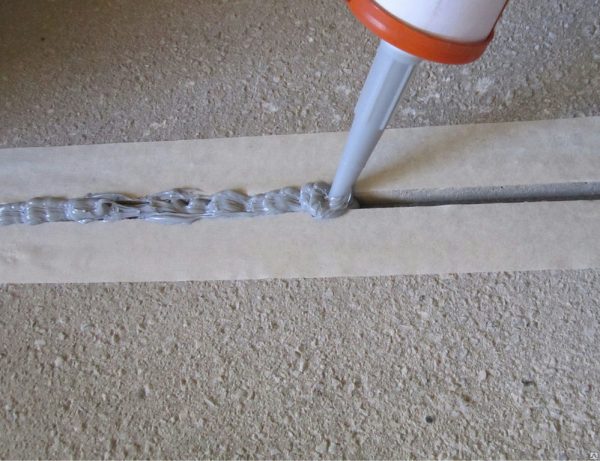When pouring concrete screed leave expansion joints that prevent cracking of the coating. In addition to such joints, there are concrete joints - they are inevitably formed when laying plates in a panel house.
- General information about joint sealants in concrete
- Types of sealants for joints and concrete defects
- Polyurethane Sealants
- Silicone sealants
- Bituminous and rubber sealants
- Butyl rubber sealants
- Thiokol Sealants
- Acrylic Sealants
- How to make joint sealing: step-by-step diagram
- Tools and equipment
- Surface preparation
- Cooking composition
- Curing Sealant Technology
- Technology for applying non-curing formulations
- Subsequent processing
- Popular brands: rating of the best sealants
- The cost of concrete sealants
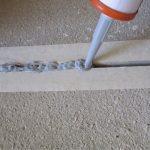
To prevent dirt, dust, water from entering the gaps, they must be protected. High-quality sealant for concrete floors, walls and floors, which has the necessary properties, will perfectly cope with this task.
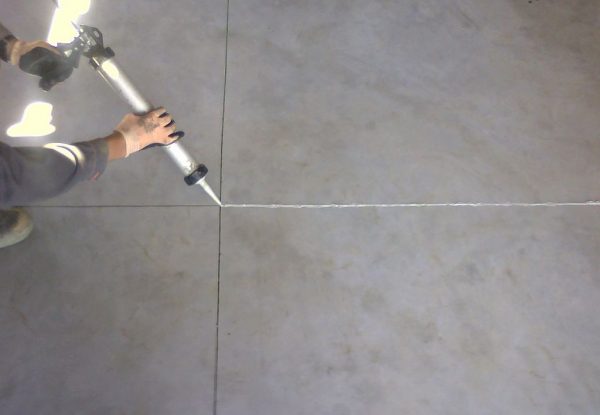
General information about joint sealants in concrete
A sealant is a pasty based on polymers or oligomers. Designed to fill various gaps and voids, it can be applied to moving and static joints. After evaporation of the solvent or during contact with moisture, the mass solidifies, forming a strong sealing layer.
Sealant for expansion joints must have special technical characteristics in order to ensure air and water tightness of joints in concrete floors. Most products are based on modern modified resins, rubber, polymers of the urethane group, which provide them with good elasticity.

It is the ability to stretch and return to its original state in the absence of shrinkage is the main distinguishing feature of sealants. If the elasticity index is not at the proper level, the seam will crack and crumble, and its service life will be reduced to a minimum.
to contents ↑Most concrete sealants are also suitable for other materials: stone, metal, wood, glass, tile. The compositions can be applied to old or freshly laid concrete: after solidification, they penetrate deeper, ensuring the strength of the connection, and control the formation of cracks on the screed.
Types of sealants for joints and concrete defects
Given the scope of operation, all sealants can be divided into several groups:
- for industrial construction;
- for housing development;
- for airfields;
- for sewers and treatment facilities;
- for hydraulic concrete structures and structures under water;
- for oil storage.
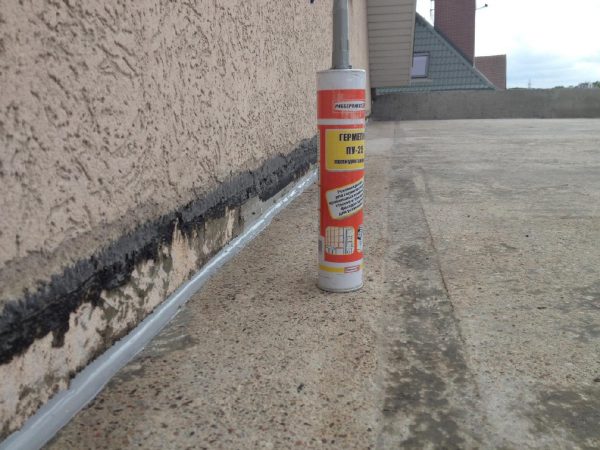
Sealants for concrete are divided by design features. Means for different surfaces are produced:
- joints of fences and supporting structures;
- doors and windows;
- horizontal joints of concrete coatings;
- wall panels;
- underground structures;
- areas subject to freezing, temperature changes or water.
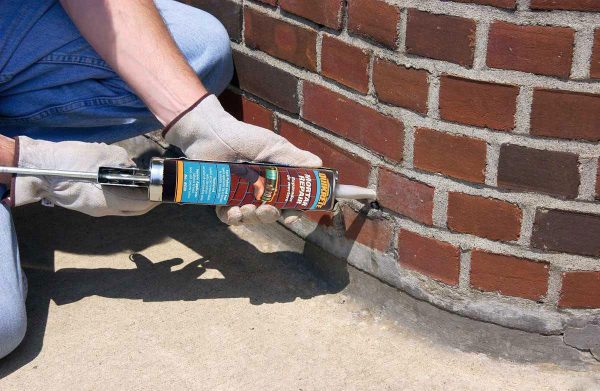
According to the principle of transition to working condition, sealants can be cured, non-cured, drying out.According to the type of penetration, they are divided into two types:
- Penetrating. They penetrate into the deep layers of concrete, clogging the pores and imparting moisture resistance to the coating.
- Superficial. Form a protective film that interferes with the penetration of moisture.
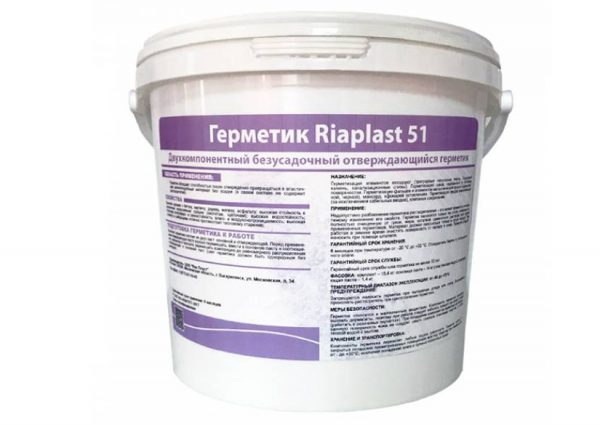
If the sealant is sold as one package and is completely ready for use, it is considered to be one-component. Two-component products are on sale, the components of which must be mixed together before use. Also, all sealants are divided into universal, for external or internal work. Differentiate the compositions and the main active substance: polyurethane, silicone, bitumen, butyl rubber, thiocol, acrylic.
to contents ↑Polyurethane Sealants
Urethane-based polymer compositions have increased elasticity and excellent moisture resistance. They can be used as joint sealants for concrete floors in order to increase the strength and durability of the screed. For work, they use a special syringe gun, into which a tube or “sausage” of sealant is immersed.
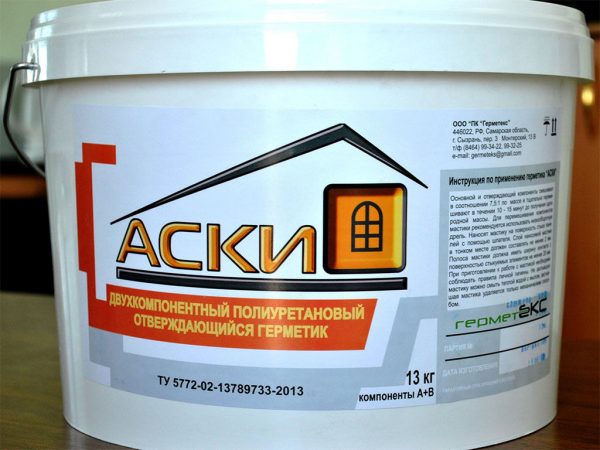
to contents ↑Polyurethane sealants are suitable for outdoor and indoor use, including for facades and foundations. They are not afraid of acids, alkalis, oils, oil products. After hardening, the seam will withstand large mechanical loads, temperature extremes, moisture.
Silicone sealants
Compositions based on silicone also have excellent elasticity, so they are suitable for concrete work. They are acidic and neutral, and the former tend to destroy natural stone and concrete surfaces, therefore, are not suitable for sealing joints.
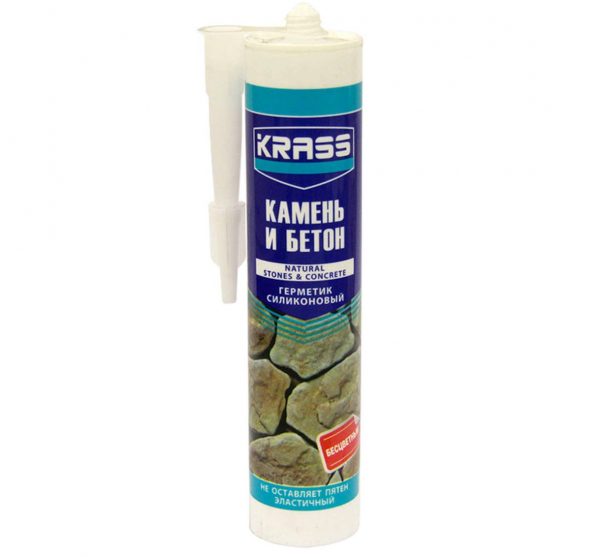
Neutral sealants with silicone withstand the influence of atmospheric factors, have a high level of adhesion to concrete, stone, metal, and do not provoke rusting of metal elements that are often present in concrete structures. They include antifungal additives, so they can be used to seal seams in septic tanks. Thanks to frost resistance, neutral silicone sealants are excellent for working with concrete outside buildings, for example, when pouring blind areas, foundations.
to contents ↑Bituminous and rubber sealants
Compositions with bitumen are characterized by the highest moisture resistance, therefore they are ideally suited for floors in rooms with high humidity, as well as for sealing seams of the roof, basement, foundation. A variety is bitumen-rubber sealants, in which artificial rubber is additionally introduced, which increases the elasticity of the composition. After drying, such products can be painted, but with frequent changes in temperature and freezing, they can become unusable faster.
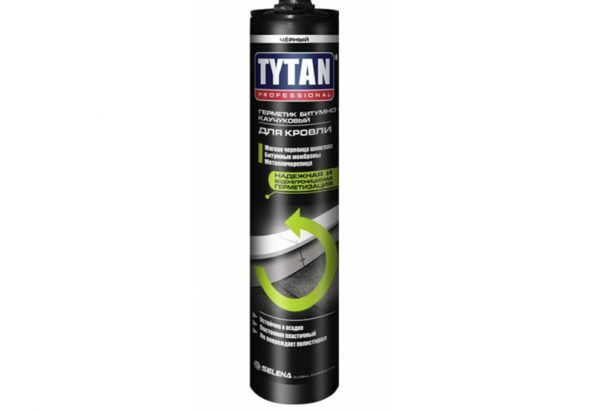
Butyl rubber sealants
After hardening, butyl rubber sealants are transformed into a strong, moisture-resistant, while highly elastic mass. They are practically not susceptible to aging, weathering, exposure to various chemicals. Compositions are often used for sealing joints, arranging insulation, sealing butt and temperature joints on roofs, facades, and building structures.
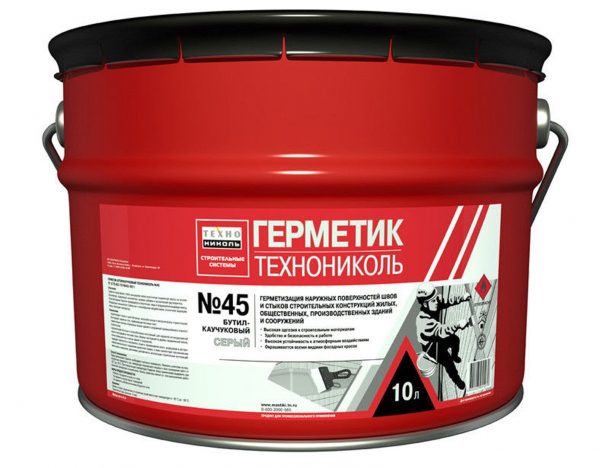
Thiokol Sealants
This type of sealant is based on polysulfides - sulfur polymer compounds. Ready seam will have the following properties:
- elasticity;
- resistance to industrial oils, salts, alkalis, acids, gasoline and other types of fuel;
- resistance to ultraviolet, ozone, moisture, air, oxygen;
- high adhesion to concrete;
- lack of corrosion in relation to metals;
- protection of concrete from dynamic and static deformations, temperature differences;
- great strength and a suitable modulus of elasticity;
- significant life.
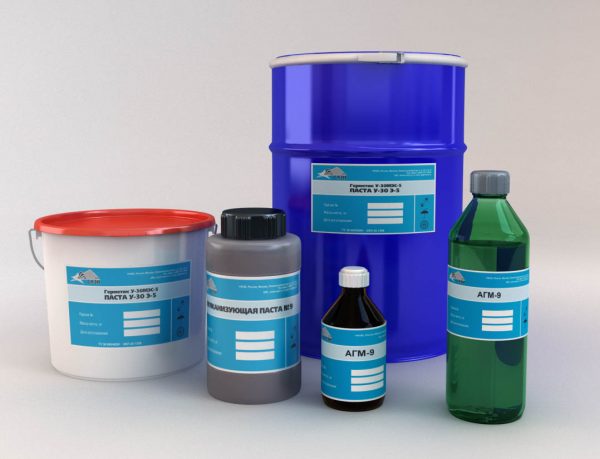
Thiocol sealants have a two-component shape and, after mixing the components, turn into non-shrink rubber. Most often they are used for sealing joints in screeds in parking lots, parking lots, airfields, garages and other places with increased load. The disadvantage of these tools is the high price and very fast curing, as a result of which professionals prefer to work with them.
to contents ↑Acrylic Sealants
Acrylic based sealants are ideally suited for interior use, as they are considered the most environmentally friendly and do not include harmful, toxic components. Such single-component compositions are used to close up cracks in the floor in areas that are not affected by humidity and temperature changes. This is due to their average resistance to adverse factors. Due to this drawback, acrylic sealants are not used in the arrangement and repair of street structures and external walls.
Positive properties of acrylic compounds:
- high vapor permeability, absence of gas exchange disturbances in the house;
- easy dilution and application;
- absolutely smooth surface after solidification;
- the possibility of applying to align and smooth the joints of the floor and walls;
- the presence of a large number of shades;
- lack of smell;
- elasticity.
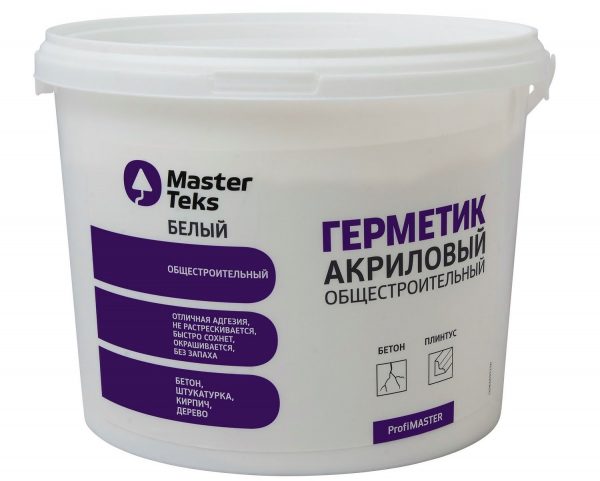
to contents ↑After complete polymerization, acrylic sealants can be painted or plastered. They are perfect not only for concrete, but also for masonry, as well as for natural stone.
How to make joint sealing: step-by-step diagram
Expansion joints also serve as cold bridges; they must be repaired to reduce the thermal conductivity of the concrete screed. Sealing must be done strictly according to the rules, while not forgetting the thorough surface preparation.
Tools and equipment
For work, you should purchase a suitable sealant, a deep penetration primer, as well as tools:
- narrow spatula for leveling the composition;
- priming brush;
- gun for sealant.
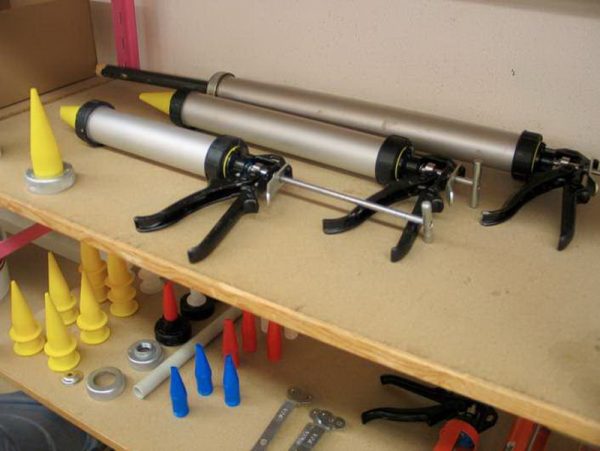
The gun is selected depending on the packaging of the purchased product: there are universal models, devices for sealants in tubes, cartridges, “sausages” or for bulk products. Professionals often use special equipment for high-precision and continuous supply of sealants, which is very important for a large processing area.
to contents ↑Surface preparation
With proper preparation, you can be sure of the high quality of adhesion of the sealant to concrete. The coating must be durable. If its parts crumble, it is worth cleaning them and treating them with concrete mix locally, and only after drying do sealing.
During the preparatory measures, all garbage is removed (with a broom, a brush or a vacuum cleaner, the cracks are blown with compressed air), they relieve the surface of traces of corrosion, decay, mold. Be sure to degrease and remove the old paint, on which the sealant lays poorly. Stubborn dirt is removed by grinding, sandblasting.
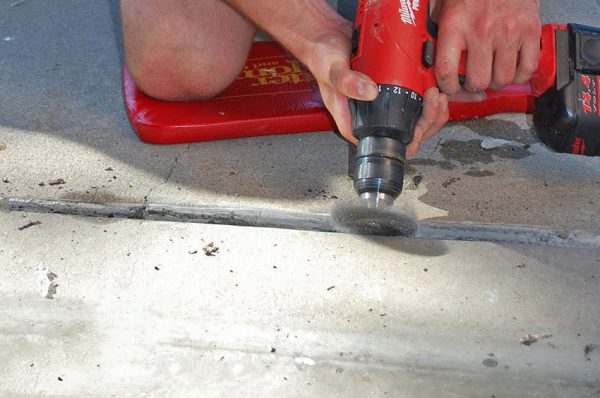
Highly porous concrete is treated with a solvent to remove residual dust, microfilms, and preservatives. The presence of defects, holes, chips, cavities is unacceptable - they must be carefully repaired.
to contents ↑Too narrow cracks, in contrast, gently expand. At the end of the preparation, the surface is treated with a primer with a high concentration of active components. The treatment area should exceed the boundaries of the sealant by at least 3-4 cm on each side.
Cooking composition
One-component products directly in the packaging you just need to insert into the gun, as they do not require preparation. In two-component compositions, paste and hardener are combined in the proportions specified by the manufacturer. It is impossible to break the ratio, otherwise the sealant will turn out to be rigid or cannot harden. Stir the material for 3-5 minutes until a homogeneous mass is obtained. If the density is too high, the composition can be diluted with gasoline or white spirit (80 ml per 1 kg).
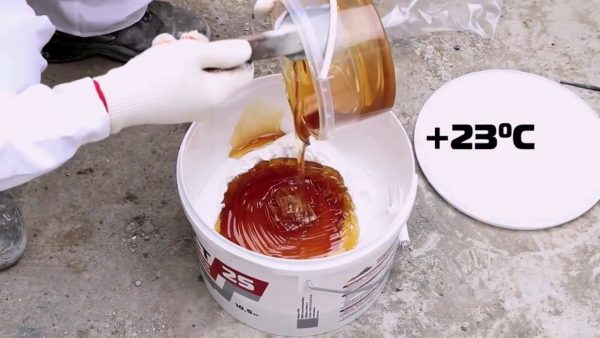
Curing Sealant Technology
It is better to apply the product from a gun, but in its absence, you can use a regular spatula. Fill cracks in the floor, evenly distributing the composition along the entire length of the seam. After that, a narrow spatula is moistened in soapy water, the sealant is leveled flush with the floor. Excess immediately removed.
During operation, it must be noted that the sealant begins to harden for a certain time. For example, acrylic compounds begin to cure after 15 minutes; on polyurethane, a strong film appears after 1 hour. If the plastic characteristics of the mass have decreased, it will be difficult to apply it, the quality of the seam may decrease. Complete drying of sealants usually lasts at least 24 hours, after which the floor will be ready for use.
to contents ↑
Technology for applying non-curing formulations
Such sealants are applied in the same way using metal syringes, wooden or iron spatulas, hoses. Some products must be heated to + 30 ... + 50 degrees before use, as indicated in the instructions. The temperature of operation of the seams should not be higher than +70 degrees, and the joints themselves from above should be closed with cement-sand mortars to increase the tightness.
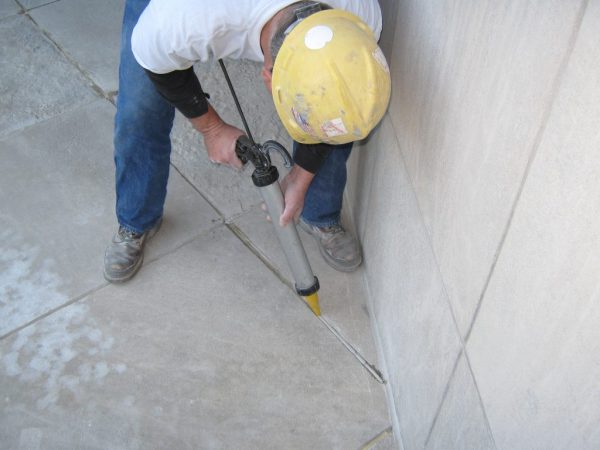
Subsequent processing
As the joint dries, it can be plastered, sprinkled with cement or sand with a layer of 1-2 mm. Some sealants may be painted if required.
Popular brands: rating of the best sealants
There are products from different manufacturers on the construction market: domestic and foreign. Among the most popular brands are the following:
- "Hermes PU-724". Two-component acrylic composition for concrete joints. It provides a high level of moisture protection, can be used for outdoor applications, has high adhesion, is durable, and can withstand drops between –60 ... + 70 degrees.
- "Sazilast 21". Thiokol sealant for concrete and other building bases. It has high resistance to sunlight, weathering, does not shrink, protects against chemicals.
- "Rustil." Polyurethane sealant for concrete, not afraid of acids, alkalis, oil products, can be painted with facade paints.
- Parabond Construction. One-component polyurethane sealant for vertical and horizontal joints. Suitable for exterior and interior use, begins to harden after 35 minutes. It works at –40 ... + 90 degrees.
- "Accent 117." Multifunctional frost-resistant acrylic composition for sealing interpanel and expansion joints. It has a very high degree of adhesion to concrete. After curing, it becomes a rubber-like material that lasts about 10 years.
- Soudaflex 40 FC. Polyurethane compound for horizontal concrete joints and vibrating substrates. Elastic, odorless, suitable for coloring, resistant to high loads.
- Dow Corning 791. Silicone, non-shrink silicone sealant. It is weatherproof, vibration resistant, tolerates any load, suitable for external and internal works. It withstands temperature differences between –50 ... + 150 degrees.

The cost of concrete sealants
The most affordable are acrylic compositions (from 150 rubles). Polyurethane products are also sold at affordable prices (from 180 rubles), silicone - from 260-350 rubles, about the same amount of thiocol compounds. Price may vary by store and manufacturer.
Concrete sealants must be selected with great care. They must be durable, serve for many years and not contain harmful components. In this case, the operation of floors or concrete structures will be comfortable and will not cause the need for repair work.



